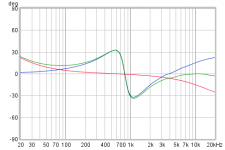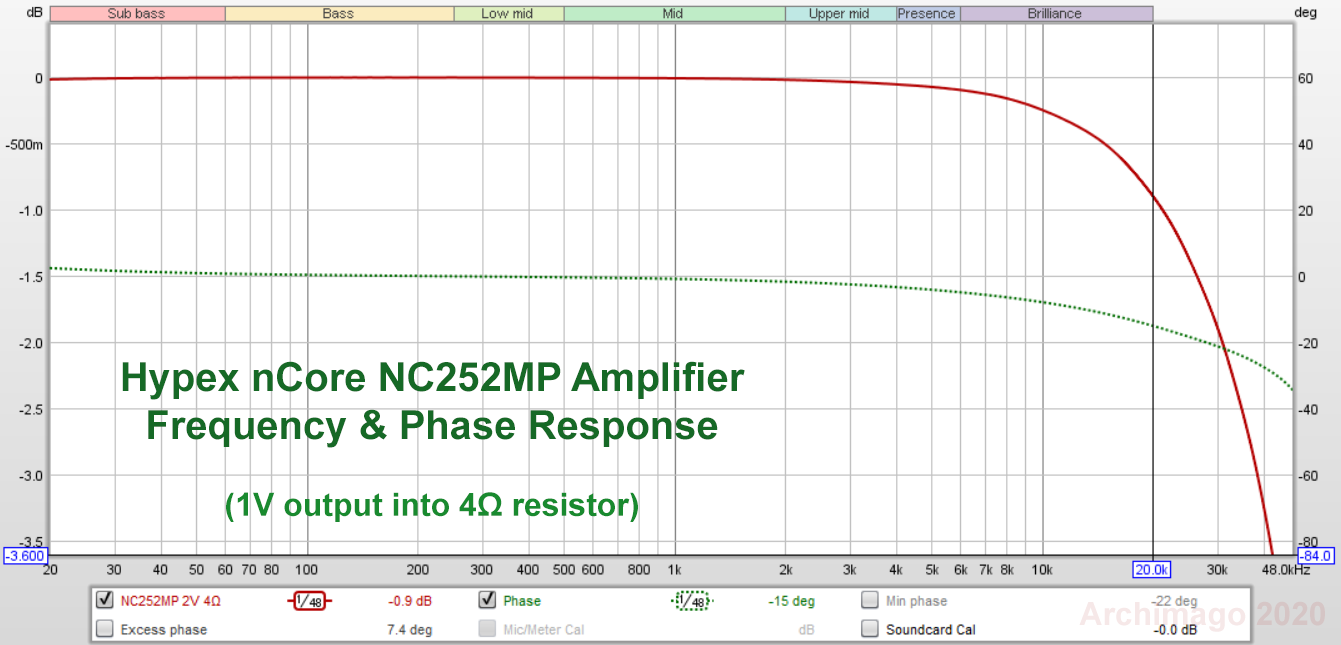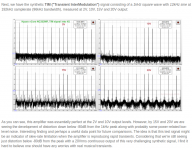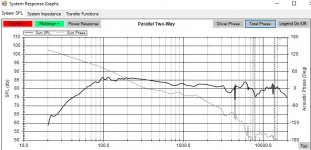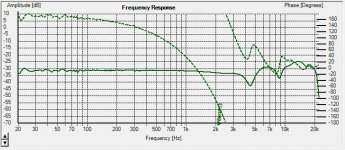Hi maty,
Phase shift distortion can sometimes be good for something 🙂 here is a documented example where power amp phaseshift kind of of repair the phase lag in a tweeter.
Below is impedance graph for a Monacor DT254 tweeter, we can see inherent inductance L(e) get the impedance to rise at VHF and so we get a rising phase lag as frq goes up seen isolated on phase curve at VHF.
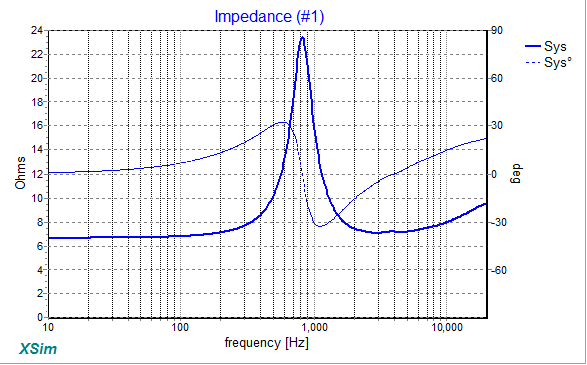
Now in a REW overlay below we can take the Emotiva amp red phase trace you claim bad because its > -6º @20kHz and times it to the blue phase trace for above tweeter and wupti we get improved phase performance close to zero degree at VHF in the green trace. Think only culprit for example can be if L(e) is not always a stable (non linear) number when voice coil moves more or less to full stroke for outward and inward directions, transducers using advanced motors often have better numbers for a more stable L(e).
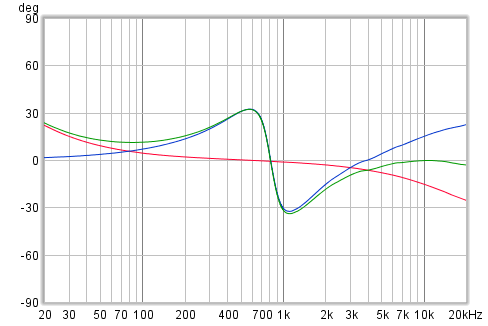
Phase shift distortion can sometimes be good for something 🙂 here is a documented example where power amp phaseshift kind of of repair the phase lag in a tweeter.
Below is impedance graph for a Monacor DT254 tweeter, we can see inherent inductance L(e) get the impedance to rise at VHF and so we get a rising phase lag as frq goes up seen isolated on phase curve at VHF.
Now in a REW overlay below we can take the Emotiva amp red phase trace you claim bad because its > -6º @20kHz and times it to the blue phase trace for above tweeter and wupti we get improved phase performance close to zero degree at VHF in the green trace. Think only culprit for example can be if L(e) is not always a stable (non linear) number when voice coil moves more or less to full stroke for outward and inward directions, transducers using advanced motors often have better numbers for a more stable L(e).
Attachments
This is different topic.
Phase lag and lead can be advantage in boost or cut frequency response. This is based on RLC transient for sound frequency. Not the same subject.
Phase lag and lead can be advantage in boost or cut frequency response. This is based on RLC transient for sound frequency. Not the same subject.
Some people do not really understand the phase shift related to sound distortion. My suggestion is please learn it from pro audio. This subject is clearly explained by them because the most case, real case is there. They play delay, phase shift, alignment etc everyday to minimize the impact of phase shift which is in worse condition: many speakers, and wide area of audience.
BYRTT, I am always thinking about the audible band, that is, up to 20 kHz. It is true that if there is information up to 24 kHz it also affects our perception of music. One of the mistakes made in modernity is having despised that additional content. That we are not able to hear tones greater than 14 kHz ... 20 kHz is another matter.
Your comment about the Bosc amplifier phase has made me think about the PURIFI...
Your comment about the Bosc amplifier phase has made me think about the PURIFI...
As I mentioned at the beginning of the thread, one wants the amplifier to influence as little as possible, that we already have enough with the variability we suffer with the speakers. If the phase is greater than 6 degrees at 20 kHz then we will have a new variable to consider, so it is a bad fact the 20 degrees a priori.
The working bandwidth must be at least 100 kHz, like is usual in a lot of class AB -> near 6 degrees at 20 kHz if I am not wrong -> no problema.
The working bandwidth must be at least 100 kHz, like is usual in a lot of class AB -> near 6 degrees at 20 kHz if I am not wrong -> no problema.
PURIFI 1ET400A
Review and Measurements of Purifi 1ET400A Amplifier | Audio Science Review (ASR) Forum

Nord Three SE 1ET400A Dual Mono Stereo Amp Review | Audio Science Review (ASR) Forum

At -3 dB, about 60 kHz.
But Bruno Putzeys said that the phase at 20 kHz is only 1º. That is why I remembered your words about the Bosc.
Phase shift in class D amplifiers. How it affects the sound?
Review and Measurements of Purifi 1ET400A Amplifier | Audio Science Review (ASR) Forum
Nord Three SE 1ET400A Dual Mono Stereo Amp Review | Audio Science Review (ASR) Forum
At -3 dB, about 60 kHz.
But Bruno Putzeys said that the phase at 20 kHz is only 1º. That is why I remembered your words about the Bosc.
Phase shift in class D amplifiers. How it affects the sound?
...look at amplitude response trace its really not smooth in it starts a rise and probably explode in a ugly huge overshoot and its that enourmous minimum phase distortion (PEQ like HF boost) that help phase trace stay at zero degree.
Last edited:
BTW, three mails interchanged with BOSC designer, with the link to your comment. He has told me several times that he does not know what I want to say, that he does not understand me...
Finally, Amirm twice asked him to measure the PURIFI 1ET400A phase graph. He has had two occasions to do so (Kit and Nord implementations). I will not ask for a third time.
Humans use phase shift to know what direction a sound is coming from.
No, if they come in front of you or behind you.
Have you any evidence for that? As far as I'm aware perception of front or behind is a function of the pinna transform.No, if they come in front of you or behind you.
BTW, three mails interchanged with BOSC designer, with the link to your comment. He has told me several times that he does not know what I want to say, that he does not understand me...
My dear friend, this sometimes happens also to me and to many others ;-)
Love, and happy 2020!
That refers to the same signal that reaches both ears (separated by a distance) and is perceived with different phases. If the sound source is very central (front or back), there is no phase difference in its arrival, and so our brain cannot specify the direction of origin. As the separation between our ears is small, we cannot calculate the direction of origin of low frequency sounds, because they have a longer wavelength and establish little phase difference at that distance.
Interesting finding and perhaps a useful data point for future comparisons.
Slew rate induced distortion in the output inductor. The 12KHz rides on top of the 1KHz. When the 1KHz is positive then the setting voltage available to the 12KHz signal is reduced whilst the resetting voltage is increased. As a result the 12KHz signal is subject to a gain variation and you get distortion products. Same for all signals and same for single tones. Do not @ me.
Slew rate induced distortion in the output inductor. The 12KHz rides on top of the 1KHz. When the 1KHz is positive then the setting voltage available to the 12KHz signal is reduced whilst the resetting voltage is increased. As a result the 12KHz signal is subject to a gain variation and you get distortion products. Same for all signals and same for single tones. Do not @ me.
Attachments
Confusing changing phase with phase shift...
OK, I'm not 100% sure of the correct terms, but this is partially based on what Winer says in his audio book. Humans are very nearly deaf to phase distortions or group delays. I understand this to mean like what a typical (?) speaker might have -90 degrees at woofer and +90 degrees at tweeter, at the x-over freq. The ear is (relatively) deaf to the discontinuity. However, the ear is very sensitive to phase changes (what I'd call a phase shift). Not only has this given guitarists the box that makes the guitar sound like a jet plane, it also makes sense from an evolution standpoint: a shift in the phase (timbre) of a sound usually means the sound is moving, perhaps an animal about to eat the listener. Or to use the OP's note, I would guess that 70 degrees phase shift is inaudible even at 1 KHz. But if it varied over short periods of time (seconds) between 45 and 85 degrees, I would certainly expect it to sound like a 1960s pop song 😀
OK, I'm not 100% sure of the correct terms, but this is partially based on what Winer says in his audio book. Humans are very nearly deaf to phase distortions or group delays. I understand this to mean like what a typical (?) speaker might have -90 degrees at woofer and +90 degrees at tweeter, at the x-over freq. The ear is (relatively) deaf to the discontinuity. However, the ear is very sensitive to phase changes (what I'd call a phase shift). Not only has this given guitarists the box that makes the guitar sound like a jet plane, it also makes sense from an evolution standpoint: a shift in the phase (timbre) of a sound usually means the sound is moving, perhaps an animal about to eat the listener. Or to use the OP's note, I would guess that 70 degrees phase shift is inaudible even at 1 KHz. But if it varied over short periods of time (seconds) between 45 and 85 degrees, I would certainly expect it to sound like a 1960s pop song 😀
Last edited:
Phase Shift from Class D Output Inductor
Gentlemen,
I just spent the last weekend trying to turn down an overly-hot AMT tweeter in my car. The amps are 40-watt Kenwood Class D. Mid and AMT in the front, woofers in back. I added 8 ohms or so in series with the tweeter, and then measured a dozen 180 shifts in the highs! The sound was lifeless, like a mediocre 5-way from the 70s.
Using a 4-ohm LPad stopped that. I have the resistors on order. This thread reminded me there is an inductor at the output to round off the stairsteps in a class D amp. If the impedance jumps to 15 ohms or something like that it will interact with the output inductor.
Lesson: No strange loads on Class D amps.
Paul
Gentlemen,
I just spent the last weekend trying to turn down an overly-hot AMT tweeter in my car. The amps are 40-watt Kenwood Class D. Mid and AMT in the front, woofers in back. I added 8 ohms or so in series with the tweeter, and then measured a dozen 180 shifts in the highs! The sound was lifeless, like a mediocre 5-way from the 70s.
Using a 4-ohm LPad stopped that. I have the resistors on order. This thread reminded me there is an inductor at the output to round off the stairsteps in a class D amp. If the impedance jumps to 15 ohms or something like that it will interact with the output inductor.
Lesson: No strange loads on Class D amps.
Paul
More Class D Load and Phase
Alright, I read about Class D amps some more, in Wikipedia. Typically they use a 2nd-order low pass filter right after the switching output stage to smooth off those timed pulses. My car dash unit is a Kenwood 4*40 watt class D from last year.
1) Has anyone fiddled with the output low pass filter for better SQ on class D amps?
2) I have a 1st order cap-for-tweeter and coil-for-woofer set in a car door. Here is concept:
https://www.diyaudio.com/forums/attachment.php?attachmentid=910046&stc=1&d=1610254598
And here is reality, mic between front headrests, woofers in back on another channel:
https://www.diyaudio.com/forums/attachment.php?attachmentid=910047&stc=1&d=1610254915
It sounds great, surprising given the enclosure is a steel door. It even has some fair imaging. But the phase curve is unexpected, it reminds me of a 12dB/Octave 2nd order CO. Would the Kenwood output low pass filter have anything to do with that, or does it work out of human hearing frequency range?
Thanks!
Paul
Alright, I read about Class D amps some more, in Wikipedia. Typically they use a 2nd-order low pass filter right after the switching output stage to smooth off those timed pulses. My car dash unit is a Kenwood 4*40 watt class D from last year.
1) Has anyone fiddled with the output low pass filter for better SQ on class D amps?
2) I have a 1st order cap-for-tweeter and coil-for-woofer set in a car door. Here is concept:
https://www.diyaudio.com/forums/attachment.php?attachmentid=910046&stc=1&d=1610254598
And here is reality, mic between front headrests, woofers in back on another channel:
https://www.diyaudio.com/forums/attachment.php?attachmentid=910047&stc=1&d=1610254915
It sounds great, surprising given the enclosure is a steel door. It even has some fair imaging. But the phase curve is unexpected, it reminds me of a 12dB/Octave 2nd order CO. Would the Kenwood output low pass filter have anything to do with that, or does it work out of human hearing frequency range?
Thanks!
Paul
Attachments
OK, listening honeymoon is over. A completely neutral piano recording sounds like the piano was made partially out of car door sheet metal. At high volumes certain piano and woodwind notes ring. It is possible that the phase flip is because the tweeter is too close, which can't be helped. Overall, it is tuned and I am satisfied with the SQ, and I won't tear into the Kenwood head unit. (Although there is a lot of room!)
Class D modifiers: Are changes to the output filters done? Have they improved the sound? Any unintended consequences?
Thanks,
Paul
Class D modifiers: Are changes to the output filters done? Have they improved the sound? Any unintended consequences?
Thanks,
Paul
Girls Who Like Class D Enthusiasts
None. OK, now that you opened this, has anyone swapped the LC output filters of Class D amps with higher-quality caps and air-core coils and improved the sound? Any unintended consequences?
Thanks!
Paul
None. OK, now that you opened this, has anyone swapped the LC output filters of Class D amps with higher-quality caps and air-core coils and improved the sound? Any unintended consequences?
Thanks!
Paul
In addition to possible AES-17 filter usage, there is also DUT latency to consider. Frequency-independent effects can confuse folks evaluating phase response graphs where the test conditions were unknown. (A proper test setup is not as straightforward as it might seem.)
The NC400 has approximately 10uS input-to-output latency. This CAN NOT be ignored during objective measurements and MUST be taken into account in the test setup when performing differential measurements to evaluate phase response.
Two plots attached:
A plot of the phase response of my Hypex NC500 amplifier from input to output. (27db voltage gain removed for clarity.)
Note the 75 degree "phase shift" at 20khz. However, that is NOT the true phase response of the amplifier.
A plot with a 10uS pure delay added into the reference channel of the differential measurement to eliminate the latency of the amplifier from the measurement. This yields the TRUE phase response of the NC500 amplifier.
Dave.
This is correct, but it doesn´t seem that anyone noticed that much 😀
But do you know for certain, that the group delay in the nCore500OEM is constant throughout the audioband?
- Home
- Amplifiers
- Class D
- Phase shift in class D amplifiers. How it affects the sound?

